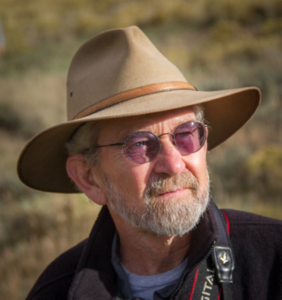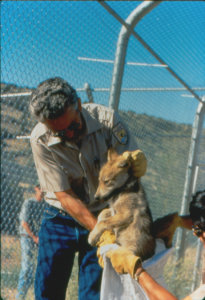Where will all the wildlife go? Should wildlife managers aid imperiled species’ migration in the face of climate change? The U.S. Fish and Wildlife Service says yes. Critics warn of ‘playing God’ and unintended consequences.
Consider the former distribution of imperiled carnivores of the American West: A grizzly bear still graces the California state flag despite being hunted to its extinction in the Golden State nearly a century ago. More than 20 subspecies of canis lupus — the gray wolf — once roamed a vast swath of North America, from northern Canada into central Mexico. Wolverines, solitary hunters and scavengers partial to mountainous environments with reliable springtime snow cover, occupied parts of California and Colorado in the early 1900s. Their range in the Lower 48 is now confined to remote outposts of the Northern Rockies and Pacific Northwest.
The primary tool the United States has for keeping those reduced ranges from contracting to nothing is the Endangered Species Act. When President Richard Nixon, a Republican, signed the act into law in 1973, he celebrated the country’s “rich array of animal life,” saying “nothing is more priceless and more worthy of preservation.” But with human activity driving a mass extinction event the likes of which Earth hasn’t seen since a meteor crashed into the Yucatan Peninsula 66 million years ago, the U.S. Fish and Wildlife Service’s nearly 50-year-old directive is becoming increasingly complicated. The agency wants to respond with more aggressive measures to ward off extinction.
On June 6, the agency unveiled a proposal that would give it more latitude to establish experimental populations of endangered or threatened species outside their current or “probable historic” range. The agency billed the measure as an “update to proven conservation tools” that could prevent more species from becoming stranded in habitats rendered unsustainable by climate change and invasive species.
“The time to act — and use every tool at our disposal — is now,” Secretary of the Interior Deb Haaland said in the release.
The agency said in emails to Montana Free Press that the proposal was not developed with particular species in mind, but public comments submitted to the agency thus far (it’s accepting comments on the proposed rule change through Aug. 8) offers clues to potential target species. Champions of Key deer, which are unique to the lower Florida Keys, describe reintroduction outside the species’ historic range as “absolutely crucial” to preventing extinction as sea levels rise. And in the West, environmentalists have long argued that the endangered Mexican wolf, currently found in southern Arizona and New Mexico as well as northern Mexico, could be introduced as far north as Colorado. But some Arizona ranchers, who’ve described the introduction of Mexican wolves as having a “devastating impact” on agricultural communities, aren’t keen on future introduction programs and their potential to introduce “economic and environmental harms.”
Though still in its earliest stages, USFWS’s proposal, sometimes called “assisted migration,” evokes sticky questions about how and where the federal government should focus its efforts and about the ultimate goals of ecological restoration. Some environmentalists have praised the agency’s proposal, calling it a conservation “game-changer” that’s long overdue. Others describe themselves as “leery” of wildlife managers’ ability to get assisted migration right, given ample evidence of past natural resource management missteps.
Ranges for many North American plants and animals are moving up — either north in latitude, or higher in elevation — according to David Parsons, a longtime USFWS biologist-turned-conservation nonprofit staffer. In some cases, he said, species are getting “pushed off the top of mountains,” meaning a species that has historically lived on one mountain or range can no longer find what it needs to survive there and has to seek refuge at even higher-elevations.
Parsons said USFWS’ assisted migration strategy would support efforts to stem the planet’s rising biological diversity loss crisis, which international leaders cited as the No. 3 risk facing the globe during the 2022 World Economic Forum. (Climate action failure topped the list, followed by extreme weather.)
“With species extinction rates a thousand times or higher than they should be, there are going to be plenty more animals in need of rescue,” Parsons said.
Both Parsons, a resident of Albuquerque, New Mexico, and Phillips, a Bozemanite, have master’s degrees in wildlife ecology and have been involved in efforts to recover the Mexican wolf, which was listed as endangered in 1976. Parsons directed the USFWS Mexican wolf recovery program from 1990 to 1999 and remains involved in his current post as the nonprofit Rewilding Institute’s carnivore conservation biologist. Phillips joined a Mexican wolf recovery advisory committee in 1995 and continued working on that effort until 2017.
“Most folks would say — and I’ve said this, too — restore to ‘historic conditions.’ It had to be really good in the past, right? Increasingly, I think that’s an inadequate answer, in part because climate change is reshuffling the ecological deck and in some cases, rendering historic ranges insignificant or not significant enough.”
MIKE PHILLIPS, DIRECTOR OF THE TURNER ENDANGERED SPECIES FUND
Mike Phillips, director of the Turner Endangered Species Fund, said in interview with Montana Free Press that the global extinction crisis “is profound.” Phillips said he supports a proposal that would give USFWS greater latitude to establish populations of threatened and endangered species outside of their current and historical ranges.
Photo by Amanda Eggert.
The two share a belief that any unintended consequences arising from the introduction of imperiled species into novel habitats — for example, a surge or decline in other plant and animal populations — can be minimized. Phillips said due diligence and an intentional, science-based plan paired with monitoring and tweaking as needed can go a long way toward preventing undesirable distortions to the complex web of interactions that underpin ecological systems.
Phillips acknowledged that mistakes will be made along the way, but said he believes in doing everything possible to address the extinction crisis. Deciding not to take action is still a decision with attendant consequences, he said. “If you want an at-bat, you have to accept the fact that you might strike out. You have to accept the fact that you may create a problem, a double play for example. But my gosh, how unexciting would life be if you don’t want an at-bat?”
Others, like Clint Nagel, a retired U.S. Geological Survey hydrologic technician who remains active in natural resource issues through his work with groups including the Gallatin Wildlife Association, cast a wary eye on the proposal. Nagel says there’s no shortage of presumably well-intentioned wildlife management efforts that have unfavorably misshapen ecological systems, including within the National Park system.
Yellowstone National Park, for example, is engaged in a decades-long, multimillion-dollar effort to rid Yellowstone Lake of lake trout, which are believed to have migrated from Lewis Lake, where they were stocked in 1890. Lake trout have wreaked havoc on the native cutthroat trout population in Yellowstone Lake, Nagel says.
About 50 miles south, the National Park Service is neck-deep in a protracted effort to get mountain goats out of Grand Teton National Park due to concerns that they’re introducing bacterial diseases to bighorn sheep and outcompeting them for forage. In February, the park used helicopters and sharpshooters to kill 58 mountain goats in Grand Teton as part of that effort.
“With species extinction rates a thousand times or higher than they should be, there are going to be plenty more animals in need of rescue.”
DAVID PARSONS, REWILDING INSTITUTE CARNIVORE CONSERVATION BIOLOGIST
Such sagas don’t bode well for heavy-handed approaches to wildlife management, Nagel argues.
“Personally, I don’t trust mankind to play God,” he said. “You know that old saying, ‘We don’t know what we don’t know’? I just see humans as being extremely arrogant where we think we know and understand the complexities of Mother Nature, and we don’t.”
Nagel acknowledged a measure of cynicism in that view, but said he worries that the federal wildlife agency has resigned itself to an extreme approach when a stronger commitment to existing conservation tools might be a better tack.
“I’d rather see the agency try to preserve the habitat that we have, rather than giving up on that and trying to put species where they may not belong,” he said.
Char Miller, a professor of environmental analysis and history at Pomona College in California, said he isn’t entirely opposed to the use of assisted migration, but calls for a vigorous vetting process first. Miller argues that natural resource managers should take a hard look at the data and focus on supporting species that have a decent shot at surviving a warmer and potentially drier climate, rather than reflexively trying to conserve existing populations of favored species.
In a recent L.A. Times op-ed, he argued that installing sprinklers at the base of giant sequoia trees in Yosemite National Park to increase their odds of surviving the nearby Washburn Fire represents a denial of current and future conditions. A more proactive approach to meaningful climate adaptation would be better, he said.
“As much as the Washburn Fire tactics caused a sigh of relief among Yosemite lovers, the Park Service needs to acknowledge that it makes no sense to install sprinklers to protect giant sequoias from conversions that a warming planet is unleashing in the Mariposa Grove and elsewhere,” he wrote. “We cannot irrigate our way out of climate change.”
Miller said humans tend not to be adept at taking a 30,000-foot view of such complicated questions, but argues that the landscape-scale changes caused by a changing climate merit a similarly expansive perspective, in both geographic and temporal terms.
Is it really appropriate, Miller asked, to attempt to save the dry conifer forests of the southwest if the temperature and precipitation necessary to keep them viable won’t materialize? And if conifer forests cede ground to a northward-expanding Sonoran desert, should people resist that ecological shift?
“The human tendency is to fix things with tools and technologies that we haven’t really interrogated,” he said, pointing to the historical use of the pesticide DDT, which forced birds of prey like bald eagles and osprey into decline, as an example. “It’s not that I want hands off,” he said. “I want minds on.”
Greta Anderson, deputy director of Western Watersheds Project, a conservation organization that focuses on protecting watersheds and wildlife habitat on western public lands, said she appreciates both the enthusiasm and skepticism USFWS’s proposal elicits.
“These are the things that I think about all of the time,” she said. “There is a truth to biogeography — species move around to suitable niches on their own, or go extinct on their own, based on fluxes in their environment. That is absolutely true. But we have unnaturally accelerated the opportunity for species to adapt and we’ve unnaturally limited their mobility within their adaptive geographic space. … We’ve bounded them.”
“Personally, I don’t trust mankind to play God. You know that old saying, ‘We don’t know what we don’t know’?”
CLINT NAGEL, RETIRED U.S. GEOLOGICAL SURVEY HYDROLOGIC TECHNICIAN
Anderson said the Endangered Species Act is sometimes likened to a safety net for imperiled plants and animals. She said she sees the rule change proposal as a “way of perhaps repairing some of the loopholes in that net.” As such, she supports it.
She also said her primary hope is that humans do more to support ecological resilience at a landscape scale to give plants and animals more room to survive on their own terms. She’s supportive of the America the Beautiful initiative President Joe Biden unveiled last year, a proposal to conserve 30% of the country’s land and water by 2030.
“I think doing land conservation and protection in the broadest way possible is what we have to do in the near-term, so that whatever we end up [pursuing] in the long-term is still possible,” she said. “If we continue to slice away the pie, those opportunities are going to be gone.”
The controversies that wildlife management can engender are no secret, particularly in Montana, which has managed to hold on to the vast majority of its native mammals. The management of animals currently or formerly on the endangered species list is arguably the most controversial of all, with advocates for or against federal protections often engaging in a decades-long tug-of-war. Sociologists sometimes use the phrase “high conflict” to describe such stubborn stalemates. They’ve found plenty of it in the management of carnivores.
As with wildlife introduction efforts, policymakers have a “pretty rocky history of involving the public well in all sorts of natural resource decisions,” said Alex Metcalf, a University of Montana professor who teaches courses on the human dimension of resource management to forestry and wildlife biology students. He underscores the importance of engaging stakeholders and “really listening” to their feedback — the earlier, the better, he said.
On paper at least, USFWS plans to develop any assisted migration programs with input from “diverse state, local and Tribal partners.” USFWS Director Martha Williams, who formerly led Montana Fish, Wildlife and Parks, expresses a commitment to “locally-driven, partnership based solutions” in agency writings about the proposal.
Metcalf anticipates that some introduction programs — of, say, trumpeter swans — could go “uneventfully well.” Others will be more fraught, he said, offering as a cautionary tale the history of gray wolf management, which reliably draws impassioned testimony in the Montana Legislature and before the state’s Fish and Wildlife Commission some 27 years after wolves from Canada were released in Yellowstone National Park. Metcalf also said there is no one-size-fits-all approach that will work everywhere. USFWS won’t necessarily be able to replicate one successfully executed introduction program in another region with a different species, he said.
“One of my mentors used to say to me, ‘Once you’ve studied one rural community, you’ve studied one rural community,” he said. “The social piece of this is really complicated.”
Asked if he has one piece of advice to offer USFWS as the agency moves into assisted migration territory, Metcalf urged patience and good-faith interactions with stakeholders, while also acknowledging the mismatched timelines of environmental need and the pace of social change.
“It’s pretty clear you cannot rush the social process. If you do, you end up with entrenched opposition among the very people you need for success. So, as uncomfortable as it may be, you have to take the time to do it right,” he said. “That’s not a comfortable answer. That’s not a happy feeling. But I think it is the reality.”
By Amanda Eggert , Montana Free Press
Ruling Says 18-year-olds Must Be Allowed to Access Their Ballots
Submitted by Rylee Sommers-Flanagan
Judge Moses of the Thirteenth Judicial District Court held Wednesday that House Bill 506, which restricts ballot access for voters who turn 18 in the month before Election Day, violates the Montana Constitution.
Youth plaintiff groups, Montana Youth Action, Forward Montana Foundation, and Montana Public Interest Research Group (MontPIRG) challenged this bill and two others last fall, alleging that the Montana Legislature had discriminated against the youngest members of the electorate. These bills weave a web of administrative challenges that deter and sometimes prevent young people from voting, denying the newest members of the electorate the systems they rely on for streamlined ballot access and election navigation.
Now one of these laws is declared unconstitutional and permanently enjoined. Even though the Legislature considered a nondiscriminatory version of the bill, the version that ultimately passed prevented election administrators from distributing ballots to young people until their 18th birthdays, even though they were qualified and eligible to vote just like any older Montanan. In other words, the bill made voting more difficult for newly 18-year-olds, but for no one else. The plaintiffs said this restriction violated the Montana Constitution’s right to suffrage, right to equal protection, and the guarantee that minors have equal access to all fundamental rights.
The Court agreed, writing: “The version of HB 506 that the Legislature ultimately passed arbitrarily subjects a subgroup of the electorate to different requirements and irrationally forecloses an avenue of voting available to all others in the electorate.”
The plaintiffs are represented in their ongoing suit by Rylee Sommers-Flanagan and Niki Zupanic of Upper Seven Law and by Ryan Aikin of Aikin Law Office.
“We are proud of the decision today,” said Scout McMahon, Initiatives Chair of Montana Youth Action. “It’s incredible to be part of the team that stopped an unconstitutional law from making it more difficult for young people to exercise their right to vote.”
“Young people’s participation in democracy is essential. Today, the Court affirmed what we already knew: restricting access to the ballot is an obvious wrong,” said Kiersten Iwai, Executive Director at Forward Montana Foundation. “Now, our newest voters can get involved at the earliest possible opportunity because they will have the same level of access to the ballot as all other Montanans. And that’s just what makes sense.”
“By restricting new voters’ access to their ballots, the legislature attempted to undermine fundamentals principles of our democracy, and they did so in violation of the Montana Constitution,” said Hunter Losing, Executive Director of MontPIRG. “The Court’s decision does justice for all Montana voters.”
About the Plaintiffs:
Montana Youth Action empowers youth in Big Sky Country to make a difference through politics, civics, and service to communities in Montana. Montana Youth Action has middle and high school student chapters across the state.
Forward Montana Foundation educates, engages, and organizes young Montanans to shape their democracy to improve their lives and the lives of their fellow Montanans.
The Montana Public Interest Research Group (MontPIRG) is a student directed and funded nonpartisan organization dedicated to effective, tangible, positive change through education and empowering the next generation of civic leaders.
About Upper Seven Law:
Upper Seven Law is a Montana-based nonprofit law firm dedicated to holding the powerful accountable. Based on the belief that creativity and innovation in law are essential to advancing social justice and public interest objectives, Upper Seven takes smart risks and invests the time necessary to build foundations for long-term accountability work.
DPHHS Wants to Hear from Montana Centenarians
The Department of Public Health and Human Services (DPHHS) wants to honor Montana centenarians during the 53rd annual Governor’s Conference on Aging October 4 – 5.
The hybrid event will take place at the Copper King Convention Center in Butte with a virtual attendance option. Centenarians will be honored at a luncheon that will begin at noon on October 4.
DPHHS is asking Montanans who will turn age 100 as of December 31, 2022, or those who are already over the age of 100 to submit their name and a brief profile. “Honoring Montana centenarians is such an important piece of the Governor’s Conference on Aging,” said DPHHS Director Charlie Brereton. “I encourage Montanans to submit the requested information so we can honor as many centenarians as possible.”
All centenarians who submit information will receive a recognition framed certificate from Governor Greg Gianforte.
Centenarians, or friends or family members, are encouraged to submit the following information by September 15, 2022, so they can be recognized.
(NOTE: The first five items are required in order to receive a certificate.)
Centenarian’s name. Contact person (who to send certificate to). Contact person’s phone number and email address. Mailing address (where to send the certificate). Birth date of centenarian. Is the centenarian a Veteran?
Where were they born? If not born in Montana, what is their story on how they got to Montana?
What is the secret to their longevity?
What has been the most amazing event in their life that they would like to share?
What is their favorite quote?
Anything else they would like us to know about the centenarian?
Please provide a picture of the centenarian when the information above is submitted.
Please send centenarian information to:
Governor’s Conference on Aging – Centenarians DPHHS – SLTC P.O. Box 4210 Helena, MT 59604-4210
Or email Nichole Thennis, DPHHS Senior and Long Term Care Division, at Nichole.Thennis@mt.gov.
Or submit your information online at Honoring Montana’s Centenarians (https://mt.accessgov.com/dphhs/Forms/Page/sltc/centenarian/0).
The annual Governor’s Conference on Aging was created in 1968 to offer information and education to our older citizens, their families, and caregivers. Attendees include the elderly, persons with disabilities and caregivers. The conference covers topics relevant to all people who are dealing with aging and disability issues.
Registration for the conference is now open. For more information about the event, including how to register, go to the conference website at conference website.
Individuals can also call toll-free at 1-800-332-2272, or call the Senior and Long Term Care Division at (406) 444-6061.
Submitted by Montana Department of Public Health and Human Services




